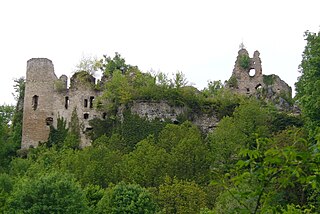
Count Frederick of Isenberg was a German noble, the younger son of Arnold of Altena. Before the split between Arnold of Altena-Isenberg the eldest and his brother Friedrich Altena-Mark the younger son of Everhard von Berg-Altena. His family castle was the Isenberg near Hattingen, Germany.
Conrad I was Duke of Swabia from 983 until 997. His appointment as duke marked the return of Conradine rule over Swabia for the first time since 948.

Kastellaun is a town in the Rhein-Hunsrück-Kreis (district) in Rhineland-Palatinate, Germany. It is the seat of the like-named Verbandsgemeinde, a kind of collective municipality.
Herman II was a member of the Conradine dynasty. He was Duke of Swabia from 997 to his death. In 1002, Herman unsuccessfully attempted to become king of Germany.

Schönau Abbey in Schönau in the Odenwald, in the Rhein-Neckar-Kreis in Baden-Württemberg, was a Cistercian monastery founded in 1142 from Eberbach Abbey. The present settlement of Schönau grew up round the monastery.

Baindt Abbey, otherwise the Imperial Abbey of Baindt, was a Cistercian nunnery in Baindt in the district of Ravensburg in Baden-Württemberg, Germany.
Engelbert II, a member of the House of Sponheim, was Margrave of Istria and Carniola from about 1103/07 until 1124. In 1123, he succeeded his elder brother Henry as Duke of Carinthia and Margrave of Verona which he held until his retirement in 1135.

The County of Sponheim was an independent territory in the Holy Roman Empire that lasted from the 11th century until the early 19th century. The name comes from the municipality of Sponheim, where the counts had their original residence.

George William, titular Count Palatine of the Rhine, Duke in Bavaria, Count of Veldenz and Sponheim was the Duke of Zweibrücken-Birkenfeld from 1600 until 1669.
Donald Charles Jackman was an American medievalist and linguist of Australian background.
Stephen I, Count of Sponheim is the patriarch of the Rhenish branch of the House of Sponheim, which ruled over the County of Sponheim. He was closely related to Siegfried I, Count of Sponheim, patriarch of the Carinthian Sponheimish branch, but the exact relationship between the two dynasts is disputed. Johannes Trithemius credits a Count Eberhard of Sponheim as founder of the Abbey of Sponheim and dates the founding to 1044, a position questioned by Johannes Mötsch. The Genealogia Sponhemica presents Count Eberhardus as son of Countess Hedwig and father of a single Count Stephenus I/II of Sponheim. Donald C. Jackman considers Stephen I a son of Siegfried I. Both Jackman and Josef Heinzelmann consider Stephen as being identical to Stephen, Vogt of Worms documented with his brother Markward in 1068. Heinzelmann however casts doubt on a male lineage relationship of Stephen and Siegfried and sees Stephen I of Sponheim as being Lord of Sponheim but not a Count, notices that Stephen I of Sponheim is documented in 1075 as "S(igna) Stepheni de Spanheim" with his seal in a document of Udo, Archbishop of Trier, and proposes Stephen to have married into the House of Sponheim. In another work Heinzelmann considers the Stephen mentioned in 1075 to be Stephen II, or maybe a single Stephen, mentions a Mainzer ministerialis Stephen, the son of Embricho (Emich) and nephew of Archbishop Ruthard, who lived later, as a possible relation, and puts forward that the documented Stephen and Markward belong to the House of the Counts of Metz/Lunéville, which later provided the Vogts of Worms:
"Identisch kann er sein mit einem Wormser Vogt Stephen (1068) [239 UB Stadt Worms I, Nr. 55], der mit seinem Bruder Markwart zu den Grafen von Lunéville/Metz zu gehören scheint, die mit den de Meti später die Wormser Vögte stellen."
Siegfried I is considered the progenitor of the Carinthian ducal House of Sponheim (Spanheimer) and all of its lateral branches, including the Counts of Lebenau and the Counts of Ortenburg. He is documented as Count of Sponheim from 1044 and served as margrave of the Hungarian March in 1045/46 and as count in the Puster Valley and the Lavant Valley from 1048 until his death.

Johann III, Count of Sponheim-Starkenburg, the Older, reigned over the County of Sponheim for 67 years. He also received many epithets such as "the Noble" and, because of his declining vision, "the Blind".
Adelaide of Savoy, a member of the Burgundian House of Savoy, was Duchess of Swabia from about 1062 until 1079 by her marriage with Rudolf of Rheinfelden, who also was elected German anti-king in 1077.

AdalbertIICount of Mörsberg was Vogt of the monasteries Allerheiligen in Schaffhausen, Switzerland, and Pfaffen-Schwabenheim near Bad Kreuznach, Germany, Count of Dill, Germany, and Mörsberg, as well as owner of the Mörsburg castle near Winterthur.
Rudolf I, Margrave of the Nordmark and Count of Stade, son of Lothair Udo II, Margrave of the Nordmark, and Oda of Werl, daughter of Herman III, Count of Werl, and Richenza of Swabia. Rudolf was the brother of his predecessors Henry I the Long and Lothair Udo III.
Stephen II was a German nobleman and an early member of the House of Sponheim. He succeeded his father, Stephen I, as count of Sponheim around 1080. Around 1092 Stephen married Sophia of Formbach. Stephen had several children with Sophia, including Meginard I, who succeeded him as count of Sponheim and Jutta, abbess of the Benedictine monastery on Disibodenberg and teacher of Hildegard of Bingen.
Bertha of Rheinfelden, countess of Kellmünz, was the daughter of Rudolf of Rheinfelden and wife of Ulrich X of Bregenz.
Sophia of Formbach, was the daughter of Meginhard V of Formbach. She was countess of Salm through her marriage to Hermann of Salm, who was also elected German anti-king from 1081 to 1088.

Friedrich Uhlhorn was an honorary professor at the Philipps-Universität Marburg, whose scientific focus was on the history of the State of Hesse and was also known for his work outside Hesse. His special scientific interest was mainly focused on the problems of historical cartography. In collaboration with Edmund Ernst Stengel, he published the Geschichtlichen Atlas von Hessen, which is considered his major work. He also wrote the article Die deutschen Territorien. A: The West, which deals with the West German regional history. Likewise he was responsible as editor for the Hessisches Jahrbuch für Landesgeschichte by Bruno Gebhardt.








